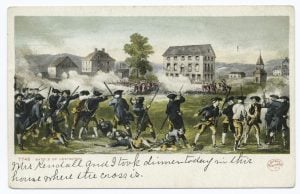4 Tips to Trace Your Roots Through American Independence
Can you find a Patriot or a Loyalist in your family tree? Start with these genealogy tips!
Postcard depicting the Battle of Lexington, Massachusetts. Courtesy of The New York Public Library.
The American Revolutionary War (1775–1783) was a turning point in the lives of countless families across the United States, Canada, and further abroad. If you’ve ever wondered whether your ancestors were involved in the fight for (or against) American independence, Revolutionary War genealogy can be an exciting journey! Tracing your roots back to the American Revolution requires a bit of creativity and an understanding of what records are available (and where to find them). This blog offers several resources to help you discover if your lineage includes Patriots or Loyalists who fought in the American Revolution.
#1: Start With What You Know: Family Lore and Documents
As with other genealogical journeys, it is important to begin with your immediate family knowledge. Does your family have an old family bible, letters, or military relics? Have you heard your grandparents talk about an ancestor who “fought in the war” or received land from a military grant?
Participants in the Revolutionary War were often young men, typically born between 1730 and 1760. Women also played a role in the conflict (often as nurses, spies, or supporters); however, their contributions may be harder to identify in the surviving documentary record.
Continue to trace your lineage backward through the 1790 United States Federal Census. Can you identify an ancestor who was of military age between 1775 and 1783?
David Dille (age 60–69), a resident of Euclid, Cuyahoga County, Ohio, during the 1830 United States Federal Census. His estimated birth year is between 1761 and 1770. Image sourced from Ancestry.
#2: Where to Find Revolutionary War Records
Once you have identified a potential ancestor, the next step is to dig into the records that can confirm their involvement in the Revolutionary War. A number of lineage societies and online databases provide access to documents from this period. These resources can help you verify and explore your connection to the American Revolution:
- Daughters of the American Revolution (DAR): The DAR maintains the Genealogical Research System (GRS), which includes verified lineages of Revolutionary War patriots, along with documents supporting each claim. The GRS is searchable online and offers an excellent starting point for discovering whether your ancestor has already been documented.
- Sons of the American Revolution (SAR): The SAR also collects lineage records and maintains the Patriot Research System (PRS), which includes service information, applications, and source documentation. This database is also searchable online.
- National Archives (NARA): NARA houses comprehensive Revolutionary War records, including pension and bounty-land warrant applications, compiled military service records, and muster rolls. Many of these collections are also available online via FamilySearch and Fold3.
- Museum of the American Revolution: The Museum of the American Revolution houses the Patriots of Color Archive (available for free via Ancestry), which documents African American and Native American soldiers who served with the Continental Army.
- Library of Virginia: The Library of Virginia offers online access to land grant files, public claims, and county court records that document military service and civilian contributions to the war effort. Other state archives may also house unique collections related to their local militia and war efforts.
When searching these online databases, be mindful of spelling variations. Names were often written phonetically. First names may be abbreviated (e.g., “Wm.” rather than “William”) or may be anglicized versions of foreign names. Boundaries and place names also changed during this era—use the FamilySearch Wiki to determine the establishment year for individual counties.
Revolutionary War pension record for David Dille of Cuyahoga County, Ohio. He served as a sergeant and a lieutenant with Colonel Crawford’s Regiment in the Virginia Militia. Image sourced from Ancestry.
#3: Where to Find Loyalist Records
Not all residents of the American colonies fought for independence. It is estimated that approximately one third of the population was loyal to the Crown, and thousands of these early American families relocated to Canada’s eastern provinces following the Revolutionary War. If you believe your ancestor supported the Crown during the American Revolution, these resources can help you verify and explore your Loyalist connection:
- United Empire Loyalists’ Association of Canada (UELAC): UELAC is the leading organization dedicated to preserving the history and legacy of the Loyalists. They also maintain the Loyalist Directory, which includes biographical details, military service records, and settlement information for over 15,000 Loyalists in Canada.
- Library and Archives Canada (LAC): LAC maintains several collections of primary documents related to Loyalist history, including land grant petitions, muster rolls, and military service records. Researchers can also access claims submitted by Loyalists for losses sustained during the American Revolution. Many of these records have been digitized and are freely accessible through the LAC website.
- Ancestry: Several Loyalist collections are also available from Ancestry, including biographical sketches for early settlers, regimental service records for the British Army, and other documents pertaining to Loyalists who fled to England. Many of these collections are also freely available via FamilySearch.
#4: Digging Deeper: Adding a Historical Context
Military service records, pension files, or bounty land applications often list enlistment dates, unit designations, or even detailed accounts of service. If you are able to identify your ancestor’s regiment, you may be able to trace the unit’s movements using regimental histories, muster rolls, or regimental war diaries! By cross-referencing dates and locations with known Revolutionary War battles, you can piece together where your ancestor might have been during pivotal moments of the American Revolution.
A detailed account of Lieut. David Dille’s service during the Revolutionary War, including his role in the Battle of Sandusky (c. 1782), was found in his pension record. Image sourced from Ancestry.
Lineage Societies
Have you identified your Patriot or Loyalist ancestor? Organizations like the Daughters of the American Revolution (DAR), the Sons of the American Revolution (SAR), and the United Empire Loyalists’ Association of Canada (UELAC) honor the memory of those who participated in the conflict—on both sides. Membership in these societies not only connects you to a community of fellow descendants but also provides opportunities to engage with historical preservation, education, and service projects.
Lineage society applications can be a rewarding but detailed process, requiring verified genealogical proof. If you are interested in joining a lineage society, be sure to visit our Lineage Society & Genealogy Research page.
Conclusion
Tracing your Revolutionary War roots can bring personal meaning to one of the most significant events in American history. With the right resources, you can uncover stories that shaped your family’s legacy. Whether your ancestor fought on the battlefield, delivered supplies, or kept the family farm running through the war, their story is part of America’s story.
Are you interested in exploring your Revolutionary War ancestry? Contact us to see how we can collaborate to uncover your family’s unique story!









